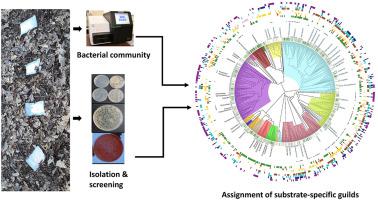Soil Biology and Biochemistry ( IF 9.7 ) Pub Date : 2022-05-05 , DOI: 10.1016/j.soilbio.2022.108696 Camelia Algora 1 , Iñaki Odriozola 1 , Zander Rainier Human 1 , Sandra Awokunle Hollá 1 , Petr Baldrian 1 , Rubén López-Mondéjar 1

|
Bacteria play critical roles in soil ecosystems when decomposing structural components of biomass. However, the ability of individual bacterial taxa to utilize various biopolymers is understudied, hampering our understanding of the role of bacteria in the soil carbon cycle. Here, we in situ incubated in forest litter various biopolymers of plant and fungal origin – cellulose, xylan, glucomannan, pectin, lignin, β-1,3-glucan, β-1,3-1,6-glucan, and chitin – to identify bacteria that associated with them during decomposition. After an incubation time of three weeks, all biopolymers were colonized by substantial bacterial numbers. The bacterial communities established on each biopolymer were specific, differing from the community on the surrounding plant litter, which indicates specialization in biopolymer utilization and the existence of distinct substrate-specific guilds. Members of Proteobacteria and Bacteroidetes predominated in all guilds. However, several biopolymers hosted members of other phyla: bacteria affiliated with Planctomycetes were enriched on cellulose, Acidobacteria on xylan, Actinobacteria on pectin, and Firmicutes on glucomannan and β-1,3-1,6-glucan. The communities on lignin had low diversity, were phylogenetically clustered and were mainly composed of Proteobacteria. The communities on chitin showed higher diversity than those on other biopolymers. Approximately 80% of biopolymer-associated bacteria were specialists and were recovered from only one or two biopolymers. Only three specific phylotypes affiliated with Burkholderia, Klebsiella and Hafnia were present on all biopolymers. Bacterial isolation confirmed the involvement of Bacteroidetes in the decomposition of chitin, Firmicutes in the decomposition of glucomannan and β-glucans, and the abundance of decomposers from Proteobacteria on all biopolymers. The proliferation of bacteria was observed on all fungally derived biopolymers and most plant-derived biopolymers. Exceptions were pectin and xylan, where bacterial counts were low – three orders of magnitude lower than in the surrounding plant litter. The results indicate the involvement of distinct, substrate-specific guilds of bacteria in the utilization of biopolymers in forest topsoil. Furthermore, by classifying soil bacteria into substrate-specific guilds, this paper contributes to efforts to assign functional traits of ecological relevance to individual members of the microbial community.
中文翻译:

植物和真菌来源的生物聚合物的具体利用揭示了温带森林土壤中细菌的底物特异性行会的存在
在分解生物质的结构成分时,细菌在土壤生态系统中起着至关重要的作用。然而,单个细菌类群利用各种生物聚合物的能力尚未得到充分研究,这阻碍了我们对细菌在土壤碳循环中的作用的理解。在这里,我们在现场在森林垃圾中培养各种植物和真菌来源的生物聚合物——纤维素、木聚糖、葡甘聚糖、果胶、木质素、β-1,3-葡聚糖、β-1,3-1,6-葡聚糖和几丁质——以识别与在分解过程中与他们一起。在三周的孵育时间后,所有生物聚合物都被大量细菌定殖。在每个生物聚合物上建立的细菌群落是特定的,与周围植物枯枝落叶上的群落不同,这表明生物聚合物利用的专业化和不同底物特异性行会的存在。变形菌门和拟杆菌门的成员在所有行会中占主导地位。然而,一些生物聚合物承载了其他门的成员:与Planctomycetes相关的细菌富含纤维素、木聚糖上的酸杆菌、果胶上的放线菌和葡甘聚糖和 β-1,3-1,6-葡聚糖上的厚壁菌门。木质素群落多样性低,系统发育聚类,主要由变形菌门组成。几丁质上的群落比其他生物聚合物上的群落表现出更高的多样性。大约 80% 的生物聚合物相关细菌是专家,并且仅从一种或两种生物聚合物中回收。所有生物聚合物中仅存在与伯克霍尔德菌属、克雷伯氏菌属和哈夫菌属有关的三种特定系统发育型。细菌分离证实了拟杆菌的参与在几丁质的分解中,厚壁菌门在葡甘聚糖和 β-葡聚糖的分解中,以及所有生物聚合物上来自变形菌的分解者的丰度。在所有真菌来源的生物聚合物和大多数植物来源的生物聚合物上都观察到了细菌的增殖。果胶和木聚糖除外,它们的细菌数量很低——比周围的植物凋落物低三个数量级。结果表明,不同的、特定于底物的细菌行会参与了森林表土中生物聚合物的利用。此外,通过将土壤细菌分类为特定基质的行会,本文有助于将与生态相关的功能特征分配给微生物群落的各个成员。



























 京公网安备 11010802027423号
京公网安备 11010802027423号